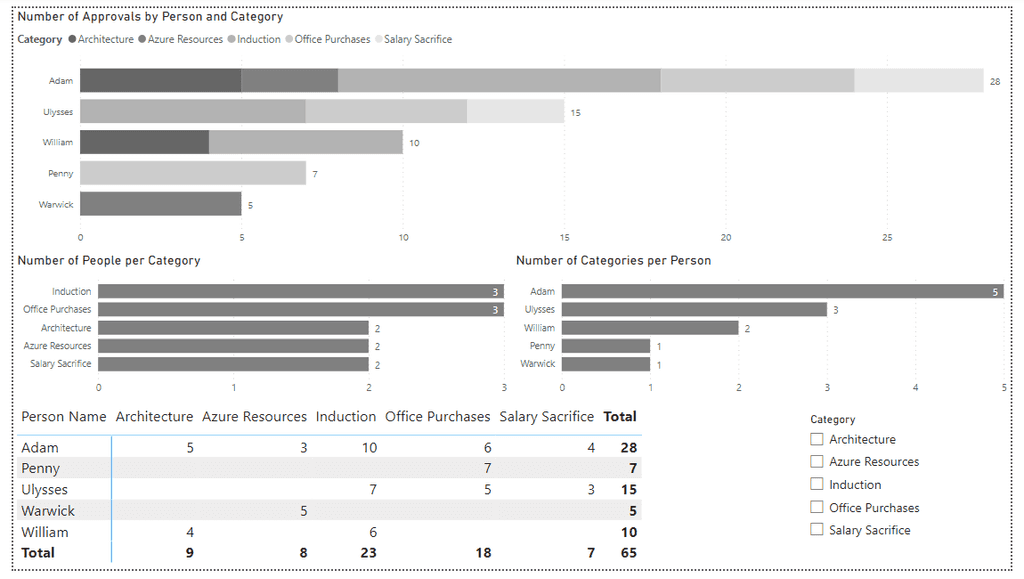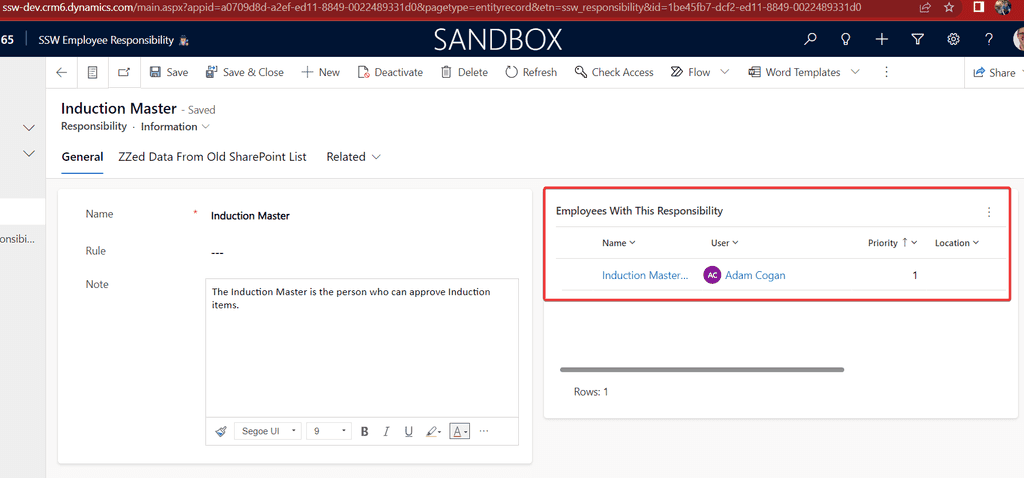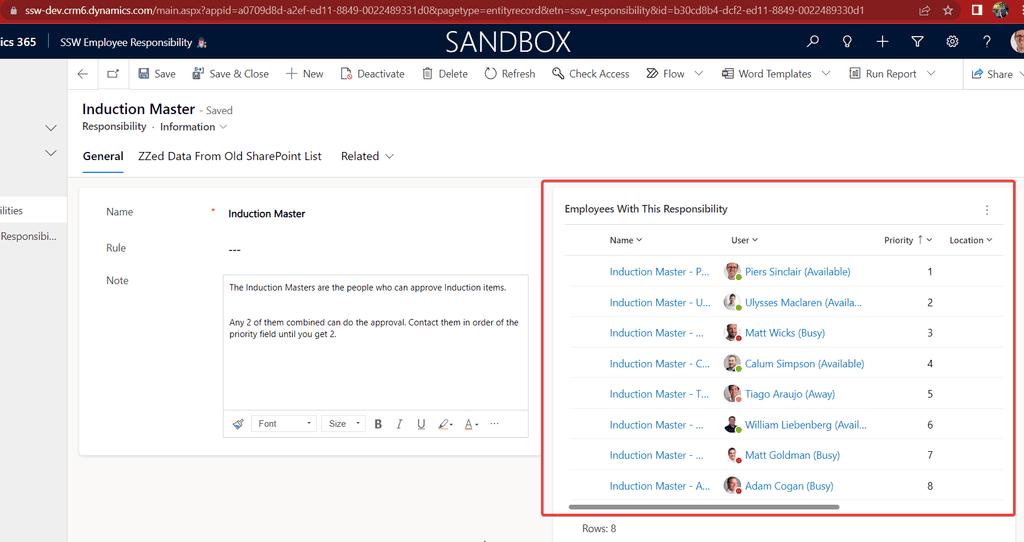Rules to Better Business Management - 4 Rules
In small companies, a single key stakeholder often approves everything, ensuring alignment with the organizational vision and strategy. However, as the company grows, this can lead to bottlenecks. One approach that addresses this is to create an employee responsibility, which lists the people responsible for a specific approval. This list ensures a clearly communicated system for cross-authorization.
Video: Cross-approvals - Do you know how to scale approvals? (4 min)
Benefits of scaling approvals
✅ Significant time savings for the person causing the bottlenecks (aka the "original approver")
✅ Fewer bottlenecks for those seeking approval
✅ Consistent and high-quality approvals
Developing the system
There are 5 steps to developing the new system of approvals:
- Identify - Find tasks causing "approval hell" aka bottlenecks
- Assign - Appoint trusted subject matter experts to be responsible
- Classify - Determine the importance of the task
- Implement - Document and induct the new approvers
- Monitor - Keep track of each employee's responsibilities
1. Process - Identify tasks causing "approval hell"
Before being able to fix "approval hell", problem tasks need to be identified.
Look for tasks which frequently take a long time to be approved.
For example, there might be delays in approval for induction completion because the person assigned to approve it is often busy.
2. Assign - Appoint trusted subject matter experts to be responsible
Start building out a list of people who are experts on that subject. Those people will become the ones responsible for approvals.
Once the list is compiled, assign each person a priority. That determines the order to contact people.
Tip: Set the "original approver" as the lowest priority to minimize their involvement.
3. Classify - Determine the importance of the task
Some tasks are more valuable than others, meaning the quality check required will differ. For example, a task to fix spelling mistakes doesn't matter as much as deleting invoices. Therefore, you would assign more approvers to the task of deleting invoices.
Figuring out the correct number of approvals can be difficult. Generally, the idea is to reduce the amount of approvals as much as possible without sacrificing quality or risk.
Here are some guidelines:
Number of Approvals: 0
The gold standard is to look for a way to remove approvals entirely. This gold standard can usually be achieved for common sense fixes using tools like Grammarly and ChatGPT. For example, you may decide that any spelling mistake fix can be applied to the company induction system as long as Grammarly has verified it.
In these cases, it becomes a rubber stamp and a 3rd party tool acts as the approver.
Number of Approvals: 1
Tasks that require 1 approval are usually well-documented, routine processes. In that case, the standard acts as the second approver since it is assumed that it has been followed.
A routine leave request is an example of a task that might require 1 approval.
Number of Approvals: 2
2 approvals are for tasks that fall into one of the following categories:
- They do not follow a well-documented process
- They frequently have variations from the process
- They are of high importance
In these cases, a 2nd approval is valuable because:
✅ It establishes confidence in the process
✅ A second perspective results in fewer mistakes slipping through
✅ A single approver may make a rushed or wrong decision
✅ The approvers hold each other accountable
A purchase for $500-$5,000 is an example of a task that might require 2 approvals because it is relatively expensive.
Number of Approvals: 3+ or stick with the "original approver"
When approval is critical to the business, it is worth considering if it should be approved by a "council" of people or by the "original approver". These are tasks where a mistake could be catastrophic for the business. For example, opening a new office might require 3 approvals because it is costly and risky.
4. Implement - Document and induct the new approvers
The final step is to record all the established decisions and induct the new approvers.
- Induct each person by having them shadow the "original approver" for at least 3 approval processes, ensuring they understand the goal
- Document the new approvers in a central repository, naming it {{ APPROVAL }} Masters
- Create a template in the Teams Approvals app to ensure a standard process is followed
- Update the standard so that instead of contacting the "original approver", individuals use the Teams approval template and contact the new approvers in order until they get the required number of approvals as determined when classifying the importance of the task

Figure: The Teams Approvals app is a good way to add structure and data capture to the system. 5. Monitor - Keep track of each employee's responsibilities
One problem with this system is responsibility creep! When someone is a trusted individual within the company, they can end up with too many responsibilities, causing new bottlenecks.
To prevent this issue, create reports tracking the number of approvals people do. That way, if someone has too many, you can reallocate some of them.

Figure: A report tracking how many approvals people do is valuable for figuring out where to distribute the workload Keeping Approvers Aligned
Sometimes, approvers may run into a controversial approval or need clarification about how to handle an approval. When that happens, they should call in the "original approver" to help resolve the problem.
Approvers may also have differing views about how to handle an approval. Disputes between 2 approvers can be solved as follows:
- The 2 approvers should have a call to get aligned about how to solve the problem
- If they still cannot agree, they should call in a 3rd approver to mediate
- If they still cannot agree, then the original approver should act as arbiter
Communicating the streamlined approvals process
This process should ideally be implemented across all business bottlenecks. However, identifying the most problematic approvals can be challenging.
To solve this, communicate the new approval process company-wide, encouraging employees to suggest areas for implementation. This crowdsourcing approach should yield valuable feedback on where to apply the streamlined approval process.
Many organizations start out with a flat management structure, valuing its simplicity and direct communication lines. However, as they grow, the lack of hierarchy and defined responsibilities in a flat structure can lead to confusion and inefficiency. This transition often prompts a critical re-evaluation of management structures, seeking alternatives that can balance flexibility with the clarity needed to scale successfully.
Flat Management Structure
Pros
✅ Simplicity - Fewer management levels, often leading to quicker decision-making.
✅ Collaboration - Makes it easy for everyone to raise their voice and feel heard.
✅ Agility - Allows for quick responses to changes and opportunities.
Cons
❌ Ambiguity and Role Confusion - Lack of specific guidelines and a clear hierarchy may lead to confusion over roles and responsibilities.
❌ Growth Challenges - May not scale well, as the head of the company can become a bottleneck.
❌ Difficulty in Accountability - Without clear reporting lines, holding individuals accountable for specific tasks or outcomes may become challenging.
❌ Imbalanced Distribution - Can result in uneven distribution of workload, decision-making power, or recognition among team members.
Hierarchical Management Structure
Pros
✅ Clarity - Well-defined lines of authority and responsibility.
✅ Vision and Control - Ensures all work aligns with company goals through centralized oversight.
✅ Stability - Established and proven by many organizations.
Cons
❌ Inflexible - May lack flexibility and responsiveness to changing needs.
❌ Potential Disconnection - Higher-levels may become disconnected from ground-level realities.
❌ Lack of Influence - Lower-level employees may feel voiceless, lacking the ability to contribute or have a say in decision-making processes.
Cross-Approval System
Pros
✅ Reduces Bottlenecks - Distributes responsibility, preventing delays.
✅ Efficiency - Streamlines the approval process, saving time.
✅ Scalability - Adaptable to different organizational sizes and complexities.
✅ Collaboration - Enhances trust and teamwork through clear guidelines.
Cons
❌ Implementation Complexity - Requires careful planning and monitoring to avoid responsibility creep or misalignment.
❌ Monitoring Required - Regular reviews and adjustments are necessary to maintain effectiveness.
❌ Potential Overhead - If not well-designed, it may add unnecessary complexity.
Conclusion
Each management structure, offers unique benefits and challenges. The choice of structure should align with the organization's goals, culture, and operational needs. Understanding the pros and cons of each can guide decision-makers in selecting or combining structures that best support efficiency, collaboration, and adaptability within their organization.
Sometimes a senior leader intervenes in an issue that could be handled by someone else who is well-informed and close to the problem. This intervention is not a good idea because it diverts focus from high importance strategic priorities that senior leaders should be involved in. Instead it is better for the senior leader to ask the person closest to the issue to fix the problem, that way they feel empowered and the senior leader can focus on strategy.
The problems
When senior leaders are involved in every level of decisions, it causes several problems including:
❌ Setting the wrong tone for how senior leadership is spending their time.
❌ Conveying a "command and control" model of management, disempowering others.
❌ Inefficient use of company resources.
The solution
When a senior leader notices an issue they think could be handled by someone else, they should do the following:
- Determine if there is an existing person responsible for fixing this issue.
- If there is, ask the person responsible to resolve the issue.
- If there isn't, check that their senior is happy to hand it over and ask the new person to to resolve the issue instead.
This delegation leads to benefits such as:
✅ Trains the employee to fix the problem and take responsibility for it in the future
✅ Employee empowerment because all employees have important decision making capability
✅ Increased efficiency because senior leaders are focused on issues which need their attention more
✅ Reduced bottlenecks in the future because senior leaders are not the only ones making decisions
You can formalize this process using the Cross-approval system which helps clarify who is responsible.
Scenario - Missing spare office keys
Imagine that the spare office keys have gone missing and it is unclear who has them.
If the CEO notices this issue, there are 2 ways to handle it:
❌ Bad Example - The CEO sends a company wide email
It's not a good idea for the CEO to send an email to everyone about this issue.
The outcome of this approach is that:
- It desensitives people to the CEOs emails because they are uninmportant
- A poor impression is given for how the CEO spends their time
- The people who are responsible for looking after the spare office keys feel disempowered
✅ Good Example - The CEO notifies the person who should be responsible for the spare office keys
A better scenario is for the CEO to email the person who should be responsible for the spare office keys and ask them to send an email to the company instead. The CEO should also communicate that they want that employee to handle this task in the future.
Conclusion
Empowering those closest to an issue to make decisions fosters efficiency and strategic focus within the business. By delegating tasks to those best suited to handle them, senior leaders can concentrate on high-priority matters, enhancing overall productivity and employee satisfaction.


